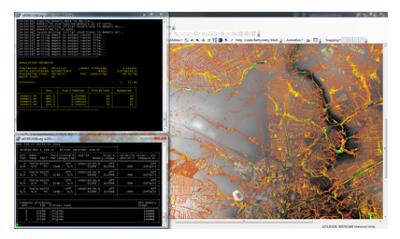HiPIMS
A high-performance integrated hydraulic and hydrological modelling software framework for catchment systems engineering
 PhD Research Project: Luke Smith
PhD Research Project: Luke Smith
The project will develop an integrated hydraulic and hydrological modelling software framework (HiPIMS) for use in catchment systems engineering. The software framework will be used to model the behaviour of runoff attenuation features in order to assess their contribution to flood mitigation as well as other secondary benefits. Data collected from the successful pilot project in Belford, Northumberland, is being used to underpin the work and modelling approaches.
Software features
- High resolution catchment scale modelling
- Advanced hydraulic capabilities
- Shock capturing
- Hydrological functionality
- Robust and accurate simulation
- Highly optimised source code
- Heterogeneous computing architecture
Possible applications include
- Large high-resolution catchment scale modelling of hydraulics and hydrology, for events characterised by intense rainfall and steep topographies
- Design and analysis of natural flood management features either existing or hypothetical, and their respective contribution to alleviating flood risk
New techniques in natural flood management, can be used to attenuate flows and reduce peak river levels. Runoff attenuation features, where landscapes, flow paths and stream channels are altered or restored to their natural state, can also accumulate sediment and improve water quality. The Environment Agency estimates investment in flood defences must almost double for the number of properties at risk in 2035 to even modestly decrease. As traditional flood defences, such as levees and walls, are not always practicable or economically viable solutions, these new techniques are increasingly being relied upon.
A pilot project funded by the Northumbrian Regional Flood Defence Committee in Belford, has provided encouraging results with attenuation features on farms near the runoff source. However there remain great uncertainties to be resolved. The project cost to date represents a fraction of comparably effective traditional defences and river engineering approaches. But further research is required to elucidate and analyse the specific impacts of each runoff attenuation feature, and develop an effective basis for the design of new features in other catchments.
This HiPIMS tool will provide a framework which is well-suited to modelling runoff attenuation features. It will improve upon traditional hydrological approaches (ie. lumped conceptual models, FEH rainfall-runoff, etc), which do not represent the true nature of physical processes within a catchment. These approaches can potentially neglect significant aspects of flow dynamics, topography and routing processes, and result in an erroneously shaped hydrograph. This project will provide a robust and physically based modelling approach, combining advanced hydraulic capabilities with hydrological functionality.

